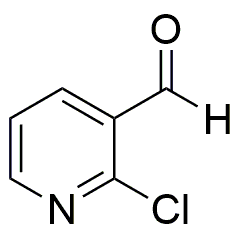2-Chloro-3-pyridinecarboxaldehyde is widely utilized in research focused on:
- Synthesis of Pharmaceuticals: This compound serves as a key intermediate in the synthesis of various pharmaceutical agents, particularly those targeting neurological disorders. Its unique structure allows for the development of novel drug candidates.
- Agricultural Chemicals: It is used in the formulation of agrochemicals, including herbicides and fungicides, enhancing crop protection and yield. This application is crucial for sustainable agriculture practices.
- Organic Synthesis: Researchers employ it in organic synthesis reactions, such as the preparation of heterocyclic compounds. Its reactivity and functional groups make it a valuable building block in organic chemistry.
- Material Science: The compound is explored in the development of advanced materials, including polymers and coatings, due to its ability to modify surface properties and improve durability.
- Analytical Chemistry: It is utilized as a reagent in analytical methods, such as chromatography, helping to identify and quantify other chemical substances effectively.
Información general
Propiedades
Seguridad y normativas
Aplicaciones
2-Chloro-3-pyridinecarboxaldehyde is widely utilized in research focused on:
- Synthesis of Pharmaceuticals: This compound serves as a key intermediate in the synthesis of various pharmaceutical agents, particularly those targeting neurological disorders. Its unique structure allows for the development of novel drug candidates.
- Agricultural Chemicals: It is used in the formulation of agrochemicals, including herbicides and fungicides, enhancing crop protection and yield. This application is crucial for sustainable agriculture practices.
- Organic Synthesis: Researchers employ it in organic synthesis reactions, such as the preparation of heterocyclic compounds. Its reactivity and functional groups make it a valuable building block in organic chemistry.
- Material Science: The compound is explored in the development of advanced materials, including polymers and coatings, due to its ability to modify surface properties and improve durability.
- Analytical Chemistry: It is utilized as a reagent in analytical methods, such as chromatography, helping to identify and quantify other chemical substances effectively.
Documentos
Hojas de datos de seguridad (HDS)
La SDS proporciona información de seguridad completa sobre la manipulación, el almacenamiento y la eliminación del producto.
Especificación del producto (PS)
La PS proporciona un desglose completo de las propiedades del producto, incluida la composición química, el estado físico, la pureza y los requisitos de almacenamiento. También detalla los rangos de calidad aceptables y las aplicaciones previstas del producto.
Certificados de análisis (COA)
Busque certificados de análisis (COA) ingresando el número de lote del producto. Los números de lote y de partida se pueden encontrar en la etiqueta de un producto después de las palabras "Lote" o "Lote".
Número de catálogo
Número de lote/lote
Certificados de origen (COO)
Este certificado de origen confirma el país en el que se fabricó el producto y también detalla los materiales y componentes utilizados en él y si se deriva de fuentes naturales, sintéticas u otras fuentes específicas. Este certificado puede ser necesario para cumplir con las normativas aduaneras, comerciales y regulatorias.
Número de catálogo
Número de lote/lote
Hojas de datos de seguridad (HDS)
La SDS proporciona información de seguridad completa sobre la manipulación, el almacenamiento y la eliminación del producto.
DownloadEspecificación del producto (PS)
La PS proporciona un desglose completo de las propiedades del producto, incluida la composición química, el estado físico, la pureza y los requisitos de almacenamiento. También detalla los rangos de calidad aceptables y las aplicaciones previstas del producto.
DownloadCertificados de análisis (COA)
Busque certificados de análisis (COA) ingresando el número de lote del producto. Los números de lote y de partida se pueden encontrar en la etiqueta de un producto después de las palabras "Lote" o "Lote".
Número de catálogo
Número de lote/lote
Certificados de origen (COO)
Este certificado de origen confirma el país en el que se fabricó el producto y también detalla los materiales y componentes utilizados en él y si se deriva de fuentes naturales, sintéticas u otras fuentes específicas. Este certificado puede ser necesario para cumplir con las normativas aduaneras, comerciales y regulatorias.


